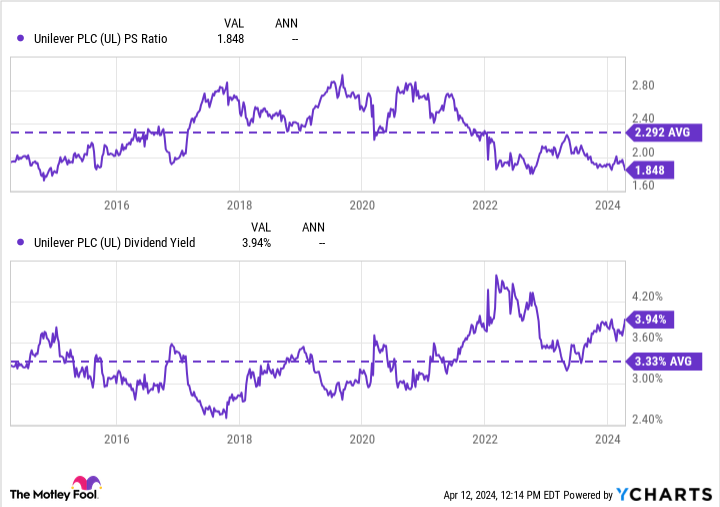Unilever (NYSE:UL) is a consumer goods giant that owns some of the world’s best-known brands, including Dove, Axe, Vaseline, Knorr and Ben & Jerry’s. With this arsenal of popular items across the consumer goods industry, the company is a perfect example of a staple stock that can form the cornerstone of any portfolio.
With a beta of 0.45, Unilever is a more stable stock than the market. However, despite being seen as a flight to safety, Unilever could provide investors with above-average total returns over the next decade.
This stock is 27% off its all-time high, trading at a one-time valuation, and paying a whopping (but safe) 3.9% dividend yield. For this reason, Unilever appears to be a buy right now.
Unilever’s portfolio of high-performing brands
Unilever has more than 400 brands sold in 190 countries. The company categorizes its operations into the following five business segments, with some examples of each:
-
Beauty and well-being (21% of sales): Dove hair and skin care, Sunsilk, TreSemmé and Clear hair care, and Pond’s and Vaseline skin care.
-
Personal care (23% of sales): Shower gel from Dove, deodorants from Ax and Rexona and toothpaste from Pepsodent and Signal.
-
Home care (20% of sales): OMO detergent, Comfort fabric softener, Sunlight dishwashing liquid and Cif cleaning products.
-
Nutrition (22% of sales): Knorr noodles, Hellmann’s dressings and other regional favorites.
-
Ice cream (13% of sales): Ben & Jerry’s, Talenti, Cornetto and Magnum.
What’s special about Unilever is that the company generates around 78% of its sales outside North America, with 58% of sales in emerging markets. These international markets provide the company with higher growth potential than expected for a company operating in the consumer goods industry.
But although underlying sales (net of foreign exchange effects) rose 7% in 2023, Unilever’s generally accepted accounting principles (GAAP) sales fell 1% due to the stronger U.S. dollar. Ultimately, these headwinds are likely to be temporary fluctuations and merely a byproduct of Unilever’s enormous global reach.
It is of utmost importance for the company to keep operations streamlined with such a global reach. That’s why management is directing its marketing focus on its 30 “power brands”. These brands accounted for about 75% of the company’s revenue in 2023 and grew 9% for the year – outpacing company-wide growth by 2 percentage points.
To further this streamlining process, Unilever recently made a surprising announcement: the impending separation of its ice cream division.

No more Ben & Jerry’s?
Unilever recently announced that it plans to spin off or sell its ice cream business, the lowest-margin unit of its five business segments. With an operating margin of just 11% – compared to an average of 17% in the other four segments – the company’s ice cream business is weighing on Unilever’s profitability.
The ice cream unit requires more capital than the other units due to its cold storage supply chain requirements. As an independent company, it could benefit from focusing on its unique business model and generating new synergies within a simpler process.
As for Unilever’s new look, this separation is expected to create a leaner, better-performing company that could receive a more favorable valuation from the market thanks to the resulting higher profit margins. This planned demerger could be the spark needed to reignite Unilever’s share price rise as the company trades near its lowest level since 2015.
The unique review of Unilever
Unilever’s dividend yield of 3.9% and price-to-sales (P/E) ratio of 1.8 make it clear that the company may be trading at its most attractive valuation in the last decade.


Unilever posted a free cash flow (FCF) margin of 12% in 2023 and trades at a tiny 15x FCF. For comparison, the company’s most similar consumer staples competitors trade at between 24 and 31 times FCF.
Armed with its impressive cash generation, the company only needed to use 62% of the FCF generated in 2023 to pay out its impressive 3.9% dividend yield. This excess cash leaves scope for future dividend increases alongside further share buybacks, which have helped Unilever’s share count fall 2% annually over the past three years.
These shareholder-friendly cash returns, combined with Unilever’s global reach, operational streamlining and reduced valuation, create a compelling core investment for patient investors willing to buy and hold the company for years to come.
Should you invest $1,000 in Unilever now?
Before you buy Unilever shares, consider the following:
The Motley Fool Stock Advisor The analyst team has just identified what they think this is The 10 best stocks so investors can buy it now… and Unilever wasn’t one of them. The ten stocks that made the cut could deliver huge returns in the years to come.
Think about when Nvidia created this list on April 15, 2005… if you have $1,000 invested at the time of our recommendation, You would have $540,321!*
Stock Advisor provides investors with an easy-to-follow roadmap to success, including guidance on building a portfolio, regular updates from analysts, and two new stock picks per month. The Stock Advisor has service more than quadrupled the return of the S&P 500 since 2002*.
See the 10 stocks »
*Stock Advisor returns from April 8, 2024
Josh Kohn-Lindquist has no position in any of the stocks mentioned. The Motley Fool recommends Unilever Plc. The Motley Fool has a disclosure policy.
1 “Magnificent Dividend” stock is down 27% and can now be bought at almost a once-in-a-decade valuation. The review was originally published by The Motley Fool
